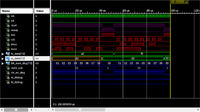electrodarkness
Member level 1
- Joined
- May 2, 2010
- Messages
- 39
- Helped
- 0
- Reputation
- 0
- Reaction score
- 0
- Trophy points
- 1,286
- Location
- Ganesti, Transylvania, Romania
- Activity points
- 1,649
Hi everyone!
I'm designing a signal acquisition board with FPGA. For the FPGA -> PC communication I'm using UART protocol. The UART design is working, I've tested it with a simple echo loopback. Next I wanted to implement a protocol to send data : S D3 D2 D1 P \r \n, where Dx are decimal numbers. For testing this I've used an 8bit sine lookup table, but when sending the data, only S and \n are sent to the terminal. I checked my code numerous times, but I can't find what's wrong with it.
I've attached my VHDL files.
Any help would be really appreciated!
Thanks in advance!
I'm designing a signal acquisition board with FPGA. For the FPGA -> PC communication I'm using UART protocol. The UART design is working, I've tested it with a simple echo loopback. Next I wanted to implement a protocol to send data : S D3 D2 D1 P \r \n, where Dx are decimal numbers. For testing this I've used an 8bit sine lookup table, but when sending the data, only S and \n are sent to the terminal. I checked my code numerous times, but I can't find what's wrong with it.
I've attached my VHDL files.
Any help would be really appreciated!
Thanks in advance!
